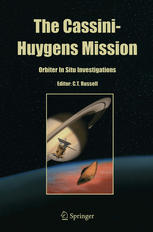

Most ebook files are in PDF format, so you can easily read them using various software such as Foxit Reader or directly on the Google Chrome browser.
Some ebook files are released by publishers in other formats such as .awz, .mobi, .epub, .fb2, etc. You may need to install specific software to read these formats on mobile/PC, such as Calibre.
Please read the tutorial at this link: https://ebookbell.com/faq
We offer FREE conversion to the popular formats you request; however, this may take some time. Therefore, right after payment, please email us, and we will try to provide the service as quickly as possible.
For some exceptional file formats or broken links (if any), please refrain from opening any disputes. Instead, email us first, and we will try to assist within a maximum of 6 hours.
EbookBell Team

4.3
28 reviewsThe joint NASA-ESA Cassini-Huygens mission promises to return four (and possibly more) years of unparalleled scientific data from the solar system’s most exotic planet, the ringed, gas giant, Saturn. Larger than Galileo with a much greater communication bandwidth, Cassini can accomplish in a single flyby what Galileo returned in a series of passes. Cassini explores the Saturn environment in three dimensions, using gravity assists to climb out of the equatorial plane to look down on the rings from above, to image the aurora and to study polar magnetospheric processes such as field-aligned currents. Since the radiation belt particle fluxes are much more benign than those at Jupiter, Cassini can more safely explore the inner regions of the magnetosphere. The spacecraft approaches the planet closer than Galileo could, and explores the inner moons and the rings much more thoroughly than was possible at Jupiter.
This book is the second volume, in a three volume set, that describes the Cassini/Huygens mission. This volume describes the in situ investigations on the Cassini orbiter: plasma spectrometer, ion and neutral mass spectrometer, energetic charged and neutral particle spectrometer, magnetometer, radio and plasma wave spectrometer and the cosmic dust analyzer. This book is of interest to all potential users of the Cassini-Huygens data, to those who wish to learn about the planned scientific return from the Cassini-Huygens mission and those curious about the processes occurring on this most fascinating planet. A third volume describes the remote sensing investigations on the orbiter.